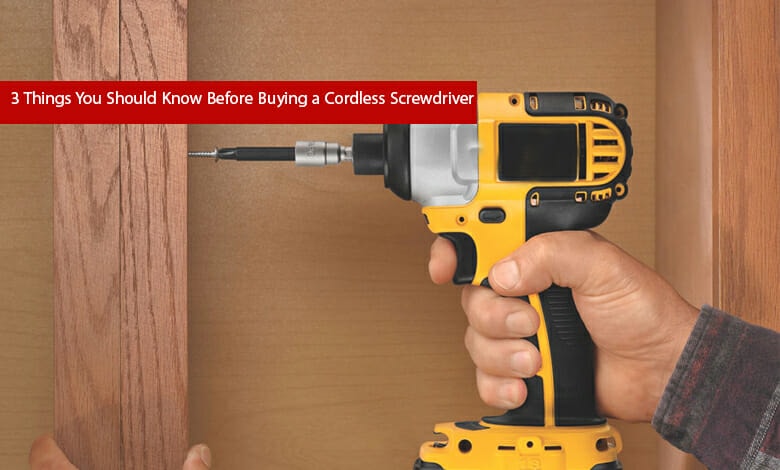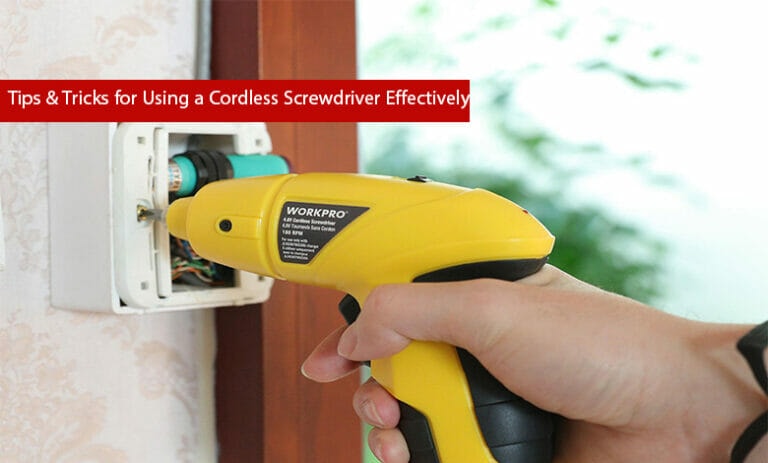
Do you ever find yourself struggling with a manual screwdriver when trying to tighten or loosen screws? Well, have you ever considered using a power screwdriver? In this article, we’re going to explore the question, “Are power screwdrivers safe to use?”
Now, I know what you might be thinking – power tools can be intimidating. But fear not, because power screwdrivers are designed with safety in mind.
So, if you’re curious about whether you should give power screwdrivers a try, keep reading to find out everything you need to know about their safety features and how they can make your DIY projects a whole lot easier!
Are Power Screwdrivers Safe to Use?
- Always wear safety goggles to protect your eyes.
- Keep your hands away from the moving parts and the tip of the screwdriver.
- Use the right size and type of screwdriver for the job.
- Do not over-tighten screws to avoid stripping them.
- Disconnect the power source before changing bits or making adjustments.
What is Power Screwdrivers
Before diving into the safety considerations, it’s important to understand what power screwdrivers are and how they work. Power screwdrivers are handheld tools that use an electric or battery-powered motor to drive screws into different materials.
They come in various sizes and configurations, including corded and cordless options. Some power screwdrivers even feature additional features such as adjustable torque settings and LED lights for better visibility.
Power screwdrivers typically have a chuck where different screwdriver bits or tips can be inserted. These bits come in a variety of shapes and sizes to accommodate different screw types. When the power screwdriver is activated, the motor rotates the bit, allowing it to drive the screw into the desired material. This automation significantly speeds up the screwdriving process and reduces the effort required.
Power Screwdriver Safety Features
Manufacturers prioritize safety when designing power screwdrivers. They incorporate various safety features to prevent accidents and ensure user protection. Here are some common safety features found in power screwdrivers:
- Clutch: Power screwdrivers often come equipped with a clutch that allows users to set the maximum torque output. This prevents screws from overdriving or damaging the material.
- LED Lights: Many power screwdrivers have built-in LED lights near the tip. These lights illuminate the work area, providing better visibility and reducing the risk of mistakes or injuries.
- Ergonomic Design: Power screwdrivers are designed to be comfortable to hold and use for extended periods. This reduces strain and fatigue on the user’s hands and prevents accidents caused by slippery grips or awkward handling.
These safety features play a crucial role in minimizing the risk of accidents and injuries associated with power screwdriver usage.
Safe Operating Practices for Power Screwdrivers
While power screwdrivers come with safety features, it’s essential to follow safe operating practices to minimize the risk of accidents and injuries. Here are some key guidelines to keep in mind:
- Read the Manual: Always read and understand the manufacturer’s instructions and safety guidelines before using a power screwdriver. Familiarize yourself with the tool’s features, limitations, and recommended usage.
- Wear Protective Gear: Use appropriate personal protective equipment (PPE) such as safety glasses to protect your eyes from flying debris. If you’re working in a noisy environment, consider using ear protection as well.
- Choose the Right Bit: Ensure that you use the correct bit for the type and size of screw you’re working with. Using an incorrect bit can lead to stripping the screw head or inefficient screwdriving, increasing the risk of accidents.
Proper Screwdriver Positioning and Technique:
- Hold the power screwdriver firmly but not too tight to maintain control and prevent slips.
- Position the screwdriver perpendicular to the surface you’re driving the screw into. angling the tool can result in misalignment and potential damage.
- Apply steady pressure while driving the screw, but avoid excessive force. The power screwdriver should do most of the work.
Choosing the Best Power Screwdriver for Your Needs
When it comes to choosing the best power screwdriver for your needs, there are several factors to consider. Let’s explore some key considerations:
Power Source: Electric or Battery-Powered?
Power screwdrivers are available in two main types: electric-powered and battery-powered. Each has its pros and cons, so it’s essential to weigh them against your specific requirements and preferences.
Electric-powered screwdrivers are corded and need to be plugged into a power outlet. They offer consistent power and are suitable for heavy-duty applications that require continuous operation. However, the cord limits their mobility and may restrict accessibility in certain situations.
Battery-powered screwdrivers, on the other hand, offer greater portability and convenience. They are rechargeable and allow you to move freely without the hassle of a cord. However, they may have limited battery life, which may require recharging during longer projects.
Speed and Torque
Speed and torque are important factors to consider when choosing a power screwdriver. Speed refers to how fast the screwdriver can rotate the bit, while torque refers to the twisting force applied to the screw.
Higher speeds and torque are generally advantageous for driving screws quickly and efficiently. However, it’s important to select a power screwdriver with adjustable speed and torque settings to best suit your specific needs and the materials you’ll be working with.
Ergonomics and Comfort
Since power screwdrivers are handheld tools that may require prolonged use, ergonomics and comfort are important factors to consider.
Look for power screwdrivers with ergonomic designs and comfortable grips that reduce hand fatigue and enhance the overall user experience. Additionally, consider the weight of the tool, as a heavy power screwdriver can lead to discomfort and strain during extended periods of use.
Additional Features
Some power screwdrivers offer additional features that can enhance your user experience and productivity.
These features may include built-in LED lights for better visibility in dimly lit areas, removable chucks for quick bit changes, and magnetic bit holders to keep screws secured during use. Evaluate the available features based on your specific needs and preferences.
Maintaining Power Screwdrivers for Longevity
To ensure the longevity and optimal performance of your power screwdriver, proper maintenance is essential. Here are some tips to keep your power screwdriver in top shape:
Regular Cleaning
Power screwdrivers can accumulate dust and debris over time, which can affect their performance. Regularly clean your power screwdriver by wiping it down with a cloth and removing any visible dirt or debris. Avoid using water or harsh cleaning chemicals, as they may damage the tool.
Lubrication
Periodically lubricate the moving parts of your power screwdriver to keep them functioning smoothly. Apply a small amount of lubricant to the chuck, clutch, and any other areas indicated in the manufacturer’s instructions. Be sure to use a lubricant specifically designed for power tools.
Battery Maintenance
If you have a battery-powered power screwdriver, proper battery maintenance is crucial. Follow the manufacturer’s instructions regarding battery charging, storage, and usage. Avoid exposing the battery to extreme temperatures and always recharge it fully before using the power screwdriver.
Storage
Store your power screwdriver in a clean and dry area, away from dust, moisture, and extreme temperatures. Keep it in a secure place to prevent accidental damage or unauthorized use.
By following these maintenance tips, you can extend the lifespan of your power screwdriver and ensure that it remains in optimal condition for your future projects.
Frequently Asked Questions
Power screwdrivers are a popular tool used for driving screws into various materials. While they can greatly improve efficiency and speed, it’s important to consider safety when using them. Here are some common questions about the safety of power screwdrivers.
1. What safety precautions should I take when using a power screwdriver?
When using a power screwdriver, it’s important to prioritize safety. Start by wearing appropriate personal protective equipment, such as safety glasses and work gloves, to safeguard against flying debris and potential injuries. Additionally, ensure that you’re using the correct type and size of screwdriver bit for the task at hand. Always follow the manufacturer’s instructions for proper operation, and never attempt to bypass safety features.
Furthermore, make sure the power screwdriver is powered off and unplugged when changing bits or making adjustments. Keep your fingers away from the moving parts and avoid excessive force, as this can lead to accidents. Always maintain a firm grip on the power screwdriver and use it on stable surfaces to reduce the risk of slips or falls. Lastly, make sure to store the tool in a safe place, away from children and pets.
2. Can power screwdrivers cause injuries?
Power screwdrivers have the potential to cause injuries if not used properly. Common injuries include cuts, abrasions, and puncture wounds. These can occur if the screwdriver slips or if the user’s hand comes into contact with the spinning bit. In some cases, more severe injuries such as fractures or amputations can occur.
However, by following safety precautions and using the tool correctly, the risk of injuries can be significantly reduced. It’s crucial to always be cautious, pay full attention to what you’re doing, and ensure that you’re properly trained on how to use the power screwdriver. Taking these precautions will help minimize the chances of accidents and injuries.
3. Can power screwdrivers be used by individuals with little experience?
Power screwdrivers can be used by individuals with little experience, as long as they take the time to learn how to use the tool safely. Beginners should start with simple projects and familiarize themselves with the basic operation of the power screwdriver. It’s advisable to read the user manual and study the manufacturer’s instructions to understand the tool’s features and limitations.
It’s also important to seek guidance from experienced users, watch tutorial videos, or attend training sessions. By gradually gaining experience and confidence, even those with little experience can become proficient in using power screwdrivers safely and effectively. Remember, practice makes perfect!
4. Are battery-powered power screwdrivers safe to use?
Yes, battery-powered power screwdrivers are generally safe to use. However, it’s essential to follow the manufacturer’s guidelines regarding battery usage and charging. Always use the correct type of battery recommended by the manufacturer and ensure it is properly inserted and secured in the tool.
Additionally, if you notice any signs of battery damage, such as leakage or swelling, it’s crucial to replace it immediately. Never expose the battery or power screwdriver to extreme temperatures or humid conditions, as this may pose a safety risk. By following these precautions, battery-powered power screwdrivers can be used safely and efficiently.
5. Can power screwdrivers be used for any type of material?
Power screwdrivers can be used for a wide range of materials. They are commonly used with wood, drywall, plastic, and even metal. However, it’s important to consider the type and thickness of the material when selecting the appropriate screw and screwdriver bit.
Certain materials, such as dense hardwoods or concrete, may require a more powerful screwdriver or specialized screws. It’s always best to consult the manufacturer’s recommendations or seek guidance from professionals to ensure the right tools and fasteners are being used for the specific material and application. This will help ensure safety and achieve optimal results.
Power screwdrivers can be safe to use if we follow some important guidelines. First, always wear protective gear like goggles and gloves to protect yourself. Second, make sure to choose the right screwdriver for the job and read the instructions carefully.
Third, check that the power tool is in good condition before using it. Lastly, be mindful of your surroundings and be cautious while handling the tool to prevent accidents.
Remember, power screwdrivers can be a helpful tool, but safety should always come first. By following these simple precautions, you can enjoy the benefits of using a power screwdriver while keeping yourself and others safe.

